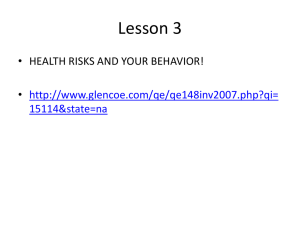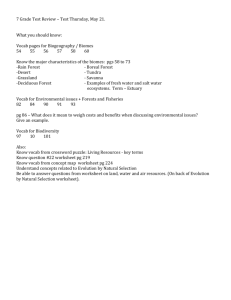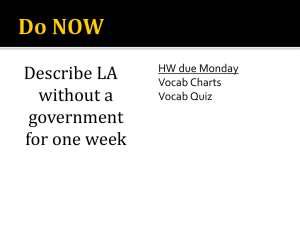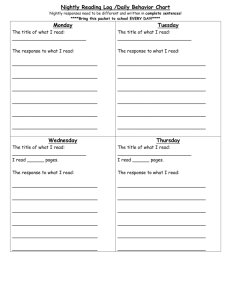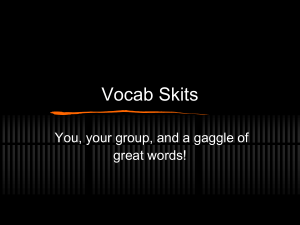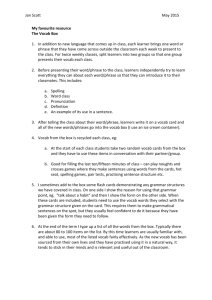Click Here for the 7th Grade Final Semester 2 Study Guide
advertisement
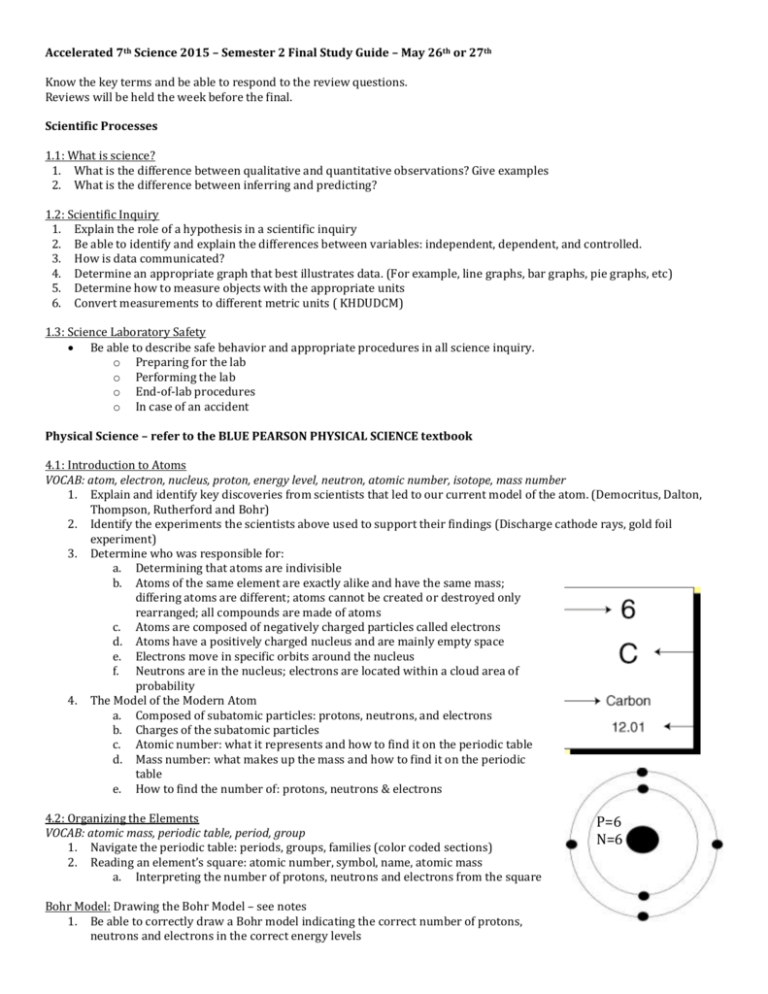
Accelerated 7th Science 2015 – Semester 2 Final Study Guide – May 26th or 27th Know the key terms and be able to respond to the review questions. Reviews will be held the week before the final. Scientific Processes 1.1: What is science? 1. What is the difference between qualitative and quantitative observations? Give examples 2. What is the difference between inferring and predicting? 1.2: Scientific Inquiry 1. Explain the role of a hypothesis in a scientific inquiry 2. Be able to identify and explain the differences between variables: independent, dependent, and controlled. 3. How is data communicated? 4. Determine an appropriate graph that best illustrates data. (For example, line graphs, bar graphs, pie graphs, etc) 5. Determine how to measure objects with the appropriate units 6. Convert measurements to different metric units ( KHDUDCM) 1.3: Science Laboratory Safety Be able to describe safe behavior and appropriate procedures in all science inquiry. o Preparing for the lab o Performing the lab o End-of-lab procedures o In case of an accident Physical Science – refer to the BLUE PEARSON PHYSICAL SCIENCE textbook 4.1: Introduction to Atoms VOCAB: atom, electron, nucleus, proton, energy level, neutron, atomic number, isotope, mass number 1. Explain and identify key discoveries from scientists that led to our current model of the atom. (Democritus, Dalton, Thompson, Rutherford and Bohr) 2. Identify the experiments the scientists above used to support their findings (Discharge cathode rays, gold foil experiment) 3. Determine who was responsible for: a. Determining that atoms are indivisible b. Atoms of the same element are exactly alike and have the same mass; differing atoms are different; atoms cannot be created or destroyed only rearranged; all compounds are made of atoms c. Atoms are composed of negatively charged particles called electrons d. Atoms have a positively charged nucleus and are mainly empty space e. Electrons move in specific orbits around the nucleus f. Neutrons are in the nucleus; electrons are located within a cloud area of probability 4. The Model of the Modern Atom a. Composed of subatomic particles: protons, neutrons, and electrons b. Charges of the subatomic particles c. Atomic number: what it represents and how to find it on the periodic table d. Mass number: what makes up the mass and how to find it on the periodic table e. How to find the number of: protons, neutrons & electrons 4.2: Organizing the Elements VOCAB: atomic mass, periodic table, period, group 1. Navigate the periodic table: periods, groups, families (color coded sections) 2. Reading an element’s square: atomic number, symbol, name, atomic mass a. Interpreting the number of protons, neutrons and electrons from the square Bohr Model: Drawing the Bohr Model – see notes 1. Be able to correctly draw a Bohr model indicating the correct number of protons, neutrons and electrons in the correct energy levels P=6 N=6 5.2 & 3: Bonding: VOCAB: ion, ionic bond, covalent bond 1. Explain what an ion is. 2. What is an ionic bond? 3. What is a covalent bond? 4. Which atoms are more likely to lose/gain electrons? 5. Which atoms are more likely to share electrons? Earth & Space Science – refer to the RED PEARSON PHYSICAL SCIENCE textbook 21: Stars, Galaxies and the Universe pg 752-771 VOCAB: constellation, apparent brightness, absolute brightness, light-year, parallax, Hertzsprung-Russell diagram, luminosity, nebula, protostar, white dwarf, supernova, neutron star, black hole, spiral galaxy 1. What are the five main ways to classify stars? 2. What does the brightness of a star depend on? 3. What is the difference between apparent brightness and absolute brightness? 4. How do scientists measure distances to stars? What is the unit that is used? a. For nearby stars b. For distant stars 5. Be able to read an H-R diagram (groupings, explain how to read the diagram) 6. Diagram out the life cycle for a. Low mass b. High mass 7. What kind of galaxy is the Milky Way? 20: The Solar System pg 698-733 VOCAB: sun, Mercury, Venus, Earth, Mars, Jupiter, Saturn, Uranus, Neptune, comet, asteroid, meteor 1. Describe how our idea of the solar system has changed over time. 2. What are four main features on the sun? How does the sun differ from the planets in our solar system? 3. How do the inner planets differ from the outer planets? 4. Identify unique characteristics about each planet (regarding either temperature, atmosphere, composition, axis, distance or size). 5. Compare and contrast comets, asteroids and meteors. 19: Earth, Moon, and Sun pg 660-665; 670-677 VOCAB: revolution, rotation, tilt, axis, hemisphere, direct sunlight, indirect sunlight, phases, waxing, waning, crescent, gibbous, eclipse, solar eclipse, lunar eclipse, high tide, low tide, spring tide, neap tide 1. Explain the difference between revolution & rotation and how it relates to the Earth, Moon and Sun. 2. What causes the cycles of the seasons? a. What does the Earth’s tilt influence? b. Explain when the Northern Hemisphere would have summer/winter c. Explain when the Southern Hemisphere would have summer/winter d. Relate the seasons to direct/indirect sunlight e. Identify a common misconception regarding the seasons 3. Explain why we have different phases of the moon (what causes different phases to be seen?) 4. Diagram out the 8 main phases of the moon starting with new moon 5. Explain how an eclipse occurs 6. What is the difference between a solar and lunar eclipse? 7. Explain how we get high tides and low tides. 8. Diagram out where high tides would be in relation to the moon 9. Diagram spring tides and explain how often they would occur. 10. Diagram neap tides and explain how often they would occur. Constellations: see notes Be able to identify the following constellations from a star chart: Ursa major, Ursa minor, the Northern cross, Scorpio, Orion, and Cassiopeia. Life Science – refer to the GREEN PEARSON PHYSICAL SCIENCE textbook 21.1: Living Things and the Environment (pg 704-706) VOCAB: organism, habitat, biotic factor, abiotic factor 1. What is the difference between biotic and abiotic factors? 2. Identify examples of biotic and abiotic factors for different environments. 21.3: Interactions among Living Things (pg 722-727) VOCAB: adaptation, natural selection, competition, predation, predator, prey, symbiosis, mutualism, commensalism, parasitism, parasite, host 1. What is adaptation? 2. How does adaptation relate to natural selection? a. Relate examples from class to adaptation and natural selection (peppered moths, butterflies, Oh Deer Lab) 3. How does competition relate to population size of organisms? 4. Explain and give examples of a producer/consumer relationship. 5. What would a graph of a producer/consumer relationship look like over generations of time? 6. Explain and give examples of a predator/prey relationship. 7. What would a graph look like for a predator/prey relationship over generations of time? 8. What is symbiosis? 9. Explain and give examples for mutualism, commensalism, and parasitism. 22.1 & 4: Ecosystems (pg 740-745) VOCAB: food chain, food web, trophic, producer, consumer (1st, 2nd, 3rd), decomposer, autotroph, heterotroph, detritivore, herbivore, omnivore, carnivore, energy pyramid, biomass, kcal 1. Explain the difference between a primary consumer, secondary and tertiary consumer. 2. Compare and contrast herbivores, omnivores, and carnivores. 3. Explain a food chain. 4. Combine different food chains together to create a food web and explain how different organisms are related. 5. Explain an energy pyramid (what happens to the energy as you move up the pyramid, which type of organism is found at each level). 6. Explain what happens to population size and biomass as you move up the pyramid. 7. What is the 10% rule and what type of pyramid does it relate to? 23.3: Biodiversity and Influencing Factors (pg 792-801) VOCAB: biodiversity, keystone species, native, exotic, invasive, extinction, endangered, carrying capacity (pg 717), captive breeding, poaching 1. What is the value of biodiversity? (2 main values) 2. Explain how area, climate, niche diversity, gene pool and extinction can influence the biodiversity of an ecosystem. 3. What are some of the main causes for extinction? (4 main ones discussed in class) 4. What are examples and advantages for introducing invasive species? 5. What are examples and disadvantages for introducing invasive species? 6. What are three things that are being done to protect biodiversity? 2.4: Looking Inside Cells VOCAB: organelle, cell wall, cell membrane, cytoplasm, mitochondria, endoplasmic reticulum, ribosome, golgi body, chloroplast, vacuole, lysosome, plant cell, animal cell, nucleus 1. 2. 3. 4. What are the main differences between a plant and animal cell? Identify the key organelles in a plant cell. Identify the key organelles in an animal cell. Know the functions of each of the cell organelles. 3.5: Cell Division VOCAB: cell cycle, interphase, G1, Synthesis, G2, prophase, metaphase, anaphase, telophase, cytokinesis, DNA, chromosome, chromatin, sister chromatids, centromere 1. 2. Explain the purpose of cell division. Identify the different phases of cell division and what is occurring at each phase. 4.1: Mendel’s Work VOCAB: heredity, trait, genetics, fertilization, purebred, gene, alleles, dominant allele, recessive allele, hybrid 1. 2. 3. 4. Who was Gregor Mendel? What did he do/discover? What is the principle of dominance (complete dominance or dominant/recessive) What is dominant? Give an example. What is recessive? Give an example. 4.2: Probability and Heredity VOCAB: punnett square, homozygous, heterozygous, phenotype, genotype, allele, gamete, offspring, dominant, recessive 1. How do geneticists use punnett squares? 2. How does the probability work? 3. Be able to find the predicted offspring for a parent cross 4. Be able to predict the parent cross from an offspring 5. Identify the genotype of the offspring 6. Identify the phenotype of the offspring 7. Give the appropriate ratio for the offspring genotype and phenotype
